Arsenic in Water and Food: Toxicity and Human Exposure
Abstract
1. Introduction
2. Toxicity and Regulatory Limits
3. Literature Studies on Arsenic Presence in Water and Food Samples
4. Human Exposure and Risk Assessment
- EDI = estimated daily intake
- MOE = margin of exposure
- BMDL = benchmark dose lower confidence limit
- EDI = estimated daily intake
5. Conclusions
Funding
Institutional Review Board Statement
Informed Consent Statement
Data Availability Statement
Conflicts of Interest
References
- Chen, Q.Y.; Costa, M. Arsenic: A global environmental challenge. Annu. Rev. Pharmacol. Toxicol. 2021, 61, 47–63. [Google Scholar] [CrossRef]
- Bundschuh, J.; Schneider, J.; Alam, M.A.; Niazi, N.K.; Herath, I.; Parvez, F.; Tomaszewska, B.; Guilherme, L.R.G.; Maity, J.P.; López, D.L.; et al. Seven potential sources of arsenic pollution in Latin America and their environmental and health impacts. Sci. Total Environ. 2021, 780, 146274. [Google Scholar] [CrossRef]
- Agency for Toxic Substances and Disease Registry (ATSDR). Support Document to the 2022 Substance Priority List (Candidates for Toxicological Profiles); Agency for Toxic Substances and Disease Registry Division of Toxicology and Human Health Sciences: Atlanta, GA, USA, 2022; pp. 1–12.
- Reis, V.; Duarte, A.C. Occurrence, distribution, and significance of arsenic speciation. Compr. Anal. Chem. 2019, 85, 1–14. [Google Scholar] [CrossRef]
- Khan, S.S.; Flora, S.J.S. 1–Arsenic: Chemistry, Occurrence, and Exposure. In Handbook of Arsenic Toxicology, 2nd ed.; Elsevier Science: Amsterdam, The Netherlands, 2023; pp. 1–49. [Google Scholar]
- EFSA CONTAM Panel; Schrenk, D.; Bignami, M.; Bodin, L.; Chipman, J.K.; del Mazo, J.; Grasl-Kraupp, B.; Hogstrand, C.; Hoogenboom, L.R.; Leblanc, J.-C.; et al. Risk assessment of small organoarsenic species in food. EFSA J. 2024, 22, e8844. [Google Scholar] [CrossRef]
- EFSA CONTAM Panel; Knutsen, H.K.; Åkesson, A.; Bampidis, V.; Bignami, M.; Bodin, L.; Chipman, J.K.; Degen, G.; Hernández-Jerez, A.; Hofer, T. Risk assessment of complex organoarsenic species in food. EFSA J. 2024, 22, e9112. [Google Scholar] [CrossRef]
- Reid, M.S.; Hoy, K.S.; Schofield, J.R.M.; Jagdeesh, S.; Uppal, J.S.; Lin, Y.; Lu, X.; Peng, H.; Le, X.C. Arsenic speciation analysis: A review with an emphasis on chromatographic separations. TrAC Trends Anal. Chem. 2020, 123, 115770. [Google Scholar] [CrossRef]
- Moe, B.; Peng, H.; Lu, X.; Chen, B.; Chen, L.W.L.; Gabos, S.; Li, X.F.; Le, X.C. Comparative cytotoxicity of fourteen trivalent and pentavalent arsenic species determined using real-time cell sensing. J. Environ. Sci. 2016, 49, 113–124. [Google Scholar] [CrossRef] [PubMed]
- Watanabe, T.; Hirano, S. Metabolism of arsenic and its toxicological relevance. Arch. Toxicol. 2013, 87, 969–979. [Google Scholar] [CrossRef]
- Campbell, K.M.; Nordstrom, D.K. Arsenic speciation and sorption in natural en- vironments. Rev. Mineral. Geochem. 2014, 79, 185–216. [Google Scholar] [CrossRef]
- EFSA CONTAM Panel; Schrenk, D.; Bignami, M.; Bodin, L.; Chipman, J.K.; del Mazo, J.; Grasl-Kraupp, B.; Hogstrand, C.; Hoogenboom, L.R.; Leblanc, J.-C. Update of the risk assessment of inorganic arsenic in food. EFSA J. 2024, 22, e8488. [Google Scholar] [CrossRef]
- World Health Organization (WHO). Guidelines for Drinking-Water Quality: Fourth Edition Incorporating the First and Second Addenda; World Health Organization: Geneva, Switzerland, 2022; pp. 1–614. ISBN 978-92-4-004506-4.
- Palma-Lara, I.; Martínez-Castillo, M.; Quintana-Pérez, J.C.; Arellano-Mendoza, M.G.; Tamay-Cach, F.; Valenzuela-Limón, O.L.; García-Montalvo, E.A.; Hernández-Zavala, A. Arsenic exposure: A public health problem leading to several cancers. Regul. Toxicol. Pharmacol. 2020, 110, 104539. [Google Scholar] [CrossRef] [PubMed]
- International Agency for Research on Cancer. IARC Monographs on the Evaluation of Carcinogenic Risks to Humans. Arsenic, Metals, Fibres, and Dusts; International Agency for Research on Cancer: Lyon, France, 2012; Volume 100C—A review of human carcinogens. [Google Scholar]
- Issanov, A.; Adewusi, B.; Saint-Jacques, N.; Dummer, T.J.B. Arsenic in drinking water and lung cancer: A systematic review of 35 years of evidence. Toxicol. Appl. Pharmacol. 2024, 483, 116808. [Google Scholar] [CrossRef]
- D’Ippoliti, D.; Santelli, E.; De Sario, M.; Scortichini, M.; Davoli, M.; Michelozzi, P. Arsenic in drinking water and mortality for cancer and chronic diseases in Central Italy, 1990–2010. PLoS ONE 2015, 10, e0138182. [Google Scholar] [CrossRef]
- Begum, M.; Horowitz, J.; Hossain, M.I. Low-dose risk assessment for arsenic: A meta-analysis approach. Asia Pac. J. Public Health 2015, 27, NP20–NP35. [Google Scholar] [CrossRef] [PubMed]
- Koutros, S.; Lenz, P.; Hewitt, S.M.; Kida, M.; Jones, M.; Schned, A.R.; Baris, D.; Pfeiffer, R.; Schwenn, M.; Johnson, A.; et al. RE: Elevated bladder cancer in northern new England: The role of drinking water and arsenic. J. Natl. Cancer Inst. 2018, 110, 1273–1274. [Google Scholar] [CrossRef]
- Khan, M.I.; Alsayegh, A.A.; Ahmad, F.; Ahmad, I.; Ashfaq, F.; Wahab, S.; Kumar, S.; Hakeem, K.R. Arsenic exposure through dietary intake and associated health hazards in the Middle East. Nutrients 2022, 14, 2136. [Google Scholar] [CrossRef]
- Sodhi, K.K.; Kumara, M.; Agrawal, P.K.; Singh, D.K. Perspectives on arsenic toxicity, carcinogenicity and its systemic remediation strategies. Environ. Technol. Innov. 2019, 16, 100462. [Google Scholar] [CrossRef]
- Cardoso, A.P.F.; Udoh, K.T.; States, J.C. Arsenic-induced changes in miRNA expression in cancer and other diseases. Toxicol. Appl. Pharmacol. 2020, 409, 115306. [Google Scholar] [CrossRef] [PubMed]
- Kaur, R.; Garkal, A.; Sarode, L.; Bangar, P.; Mehta, T.; Singh, D.P.; Rawal, R. Understanding arsenic toxicity: Implications for environmental exposure and human health. J. Hazard. Mat. Lett. 2024, 5, 100090. [Google Scholar] [CrossRef]
- Agency for Toxic Substances and Disease Registry (ATSDR); Division of Toxicology and Human Health Sciences. Addendum to the Toxicological Profile for Arsenic. Supplement to the 2007 Toxicological Profile for Arsenic; Agency for Toxic Substances and Disease Registry: Atlanta, GA, USA, 2016; pp. 1–188.
- Moon, K.A.; Guallar, E.; Umans, J.G.; Devereux, R.B.; Best, L.G.; Francesconi, K.A.; Goessler, W.; Pollak, J.; Silbergeld, E.K.; Howard, B.V.; et al. Association between exposure to low to moderate arsenic levels and incident cardiovascular disease. A prospective cohort study. Ann. Intern. Med. 2013, 159, 649–659. [Google Scholar] [CrossRef]
- Huang, Z.; Guo, L.; Huang, J.; Chen, X.; Sun, J.; Ye, Y.; Sheng, L.; Zhang, Y.; Zhou, J.; Ji, J.; et al. Neurotoxicity and brain metabolic dysfunction induced by long-term food-derived arsenic exposure. Food Biosci. 2024, 59, 103804. [Google Scholar] [CrossRef]
- Du, X.; Tian, M.; Wang, X.; Zhang, J.; Huang, Q.; Liu, L.; Shen, H. Cortex and hippocampus DNA epigenetic response to a long-term arsenic exposure via drinking water. Environ. Pollut. 2018, 234, 590–600. [Google Scholar] [CrossRef] [PubMed]
- Giles, B.H.; Mann, K.K. Arsenic as an immunotoxicant. Toxicol. Appl. Pharmacol. 2022, 454, 116248. [Google Scholar] [CrossRef]
- Balali-Mood, M.; Naseri, K.; Tahergorabi, Z.; Khazdair, M.R.; Sadeghi, M. Toxic mechanisms of five heavy metals: Mercury, lead, chromium, cadmium, and arsenic. Front. Pharmacol. 2021, 12, 643972. [Google Scholar] [CrossRef]
- Bocca, B.; Pino, A.; Vecchi Brumatti, L.; Rosolen, V.; Ronfani, L.; D’Aversa, J.; Ruggieri, F.; Petrucci, F.; Calamandrei, G.; Barbone, F.; et al. Children exposure to inorganic and organic arsenic metabolites: A cohort study in Northeast Italy. Environ. Pollut. 2020, 265, 114826. [Google Scholar] [CrossRef] [PubMed]
- World Health Organization (WHO). Guidelines for Drinking-Water Quality: Vol. 1–Recommendations, 2nd ed.; World Health Organization: Geneva, Switzerland, 1993; pp. 1–202.
- Food and Drug Administration. Code of Federal Regulations. 21 CFR 165.110 Bottled Water; Food and Drug Administration: Silver Spring, MD, USA, 2025; pp. 1–28.
- The European Parliament and the Council of the European Union. Directive (EU) 2184/2020 of the European Parliament and of the Council of 16 December 2020 on the Quality of Water Intended to Human Consumption. Off. J. Eur. Union. 2020, L 435, 1–62. [Google Scholar]
- Frisbie, S.H.; Mitchell, E.J. Arsenic in drinking water: An analysis of global drinking water regulations and recommendations for updates to protect public health. PLoS ONE 2022, 17, e0263505. [Google Scholar] [CrossRef]
- The European Commission. Commission Regulation (EU) 915/2023 of 25 April 2023 on Maximum Levels for Certain Contaminants in Food and Repealing Regulation (EC) 1881/2006. Off. J. Eur. Union. 2023, L 119, 103–157. [Google Scholar]
- The Codex Alimentarius Commission. CXC 77-2017 Code of Practice for the Prevention and Reduction of Arsenic Contamination in Rice (Revision 2017). In Codex Alimentarius; Food and Agriculture Organization of the United Nations: Rome, Italy, 2017; pp. 1–4. [Google Scholar]
- The Codex Alimentarius Commission. CXS 193-1995 General Standard for Contaminants and Toxins in Food and Feed (Revision 2023). In Codex Alimentarius; Food and Agriculture Organization of the United Nations: Rome, Italy, 1995; pp. 1–85. [Google Scholar]
- Food and Drug Administration (FDA). Inorganic Arsenic in Rice Cereals for Infants: Action Level Guidance for Industry; U.S. Department of Health and Human Services: Washington, DC, USA; Food and Drug Administration Center for Food Safety and Applied Nutrition: College Park, MD, USA, 2020; pp. 1–8.
- Food and Drug Administration (FDA). Action Level for Inorganic Arsenic in Apple Juice: Guidance for Industry; U.S. Department of Health and Human Services: Washington, DC, USA; Food and Drug Administration Center for Food Safety and Applied Nutrition: College Park, MD, USA, 2023; pp. 1–13.
- Podgorski, J.; Berg, M. Global threat of arsenic in groundwater. Science 2020, 368, 845–850. [Google Scholar] [CrossRef]
- Shaji, E.; Santosh, M.; Sarath, K.V.; Prakash, P.; Deepchand, V.; Divya, B.V. Arsenic contamination of groundwater: A global synopsis with focus on the Indian Peninsula. Geosci. Front. 2021, 12, 101079. [Google Scholar] [CrossRef]
- European Food Safety Authority (EFSA); Arcella, D.; Cascio, C.; Gómez Ruiz, J.Á. Scientific report on the chronic dietary exposure to inorganic arsenic. EFSA J. 2021, 19, 6380. [Google Scholar] [CrossRef]
- Kabir, M.S.; Salam, M.A.; Paul, D.N.R.; Hossain, M.I.; Rahman, N.M.F.; Aziz, A.; Latif, M.A. Spatial variation of arsenic in soil, irrigation water, and plant parts: A microlevel study. Sci. World J. 2016, 2186069, 1–14. [Google Scholar] [CrossRef]
- Abedi, T.; Mojiri, A. Arsenic uptake and accumulation mechanisms in rice species. Plants 2020, 9, 129. [Google Scholar] [CrossRef] [PubMed]
- Awasthi, S.; Chauhan, R.; Srivastava, S.; Tripathi, R.D. The journay or arsenic from soil to grain in rice. Front. Plant Sci. 2017, 8, 1007. [Google Scholar] [CrossRef]
- Mitra, A.; Chatterjee, S.; Moogouei, R.; Gupta, D.K. Arsenic accumulation in rice and probable mitigation approaches: A review. Agronomy 2017, 7, 67. [Google Scholar] [CrossRef]
- Mishra, S.; Mattusch, J.; Wennrich, R. Accumulation and transformation of inorganic and organic arsenic in rice and role of thiol-complexation to restrict their translocation to shoot. Sci. Rep. 2017, 7, 40522. [Google Scholar] [CrossRef]
- Kalita, J.; Pradhan, A.K.; Shandilya, Z.M.; Tanti, B. Arsenic stress responses and tolerance in rice: Physiological, cellular and molecular approaches. Rice Sci. 2018, 25, 235–249. [Google Scholar] [CrossRef]
- Mishra, S.; Dwivedi, S.; Gupta, A.; Tiwari, R.K. Evaluating the efficacy and feasibility of post harvest methods for arsenic removal from rice grain and reduction of arsenic induced cancer risk from rice-based diet. Sci. Total Environ. 2023, 874, 162443. [Google Scholar] [CrossRef]
- Otero, X.L.; Tierra, W.; Atiaga, O.; Ganoluisa, D.; Nunes, L.M.; Ferreira, T.O.; Ruales, J. Arsenic in rice agrosystems (water, soil and rice plants) in Guayas and Los Ríos provinces, Ecuador. Sci. Total Environ. 2016, 573, 778–787. [Google Scholar] [CrossRef]
- Atiaga-Franco, O.L.; Otero, X.L.; Gallego-Picó, A.; Escobar-Castañeda, L.A.; Bravo-Yagüe, J.C.; Carrera-Villacrés, D. Analysis of total arsenic content in purchased rice from Ecuador. Czech J. Food Sci. 2019, 37, 425–431. [Google Scholar] [CrossRef]
- Li, X.; Xie, K.; Yue, B.; Gong, Y.; Shao, Y.; Shang, X.; Wu, Y. Inorganic arsenic contamination of rice from Chinese major rice-producing areas and exposure assessment in Chinese population. Sci. China Chem. 2015, 58, 1898–1905. [Google Scholar] [CrossRef]
- González, N.; Calderón, J.; Rúbies, A.; Bosch, J.; Timoner, I.; Castell, V.; Marquès, M.; Nadal, M.; Domingo, J.L. Dietary exposure to total and inorganic arsenic via rice and rice-based products consumption. Food Chem. Toxicol. 2020, 141, 111420. [Google Scholar] [CrossRef]
- Guillod-Magnin, R.; Brüschweiler, B.J.; Aubert, R.; Haldimann, M. Arsenic species in rice and rice-based products consumed by toddlers in Switzerland. Food Addit. Contam. Part A 2018, 35, 1164–1178. [Google Scholar] [CrossRef] [PubMed]
- Halder, D.; Biswas, A.; Šlejkovec, Z.; Chatterjee, D.; Nriagu, J.; Jacks, G.; Prosun Bhattacharya, P. Arsenic species in raw and cooked rice: Implications for human health in rural Bengal. Sci. Total Environ. 2014, 497–498, 200–208. [Google Scholar] [CrossRef] [PubMed]
- Jitaru, P.; Millour, S.; Roman, M.; El Koulali, K.; Noël, L.; Guérin, T. Exposure assessment of arsenic speciation in different rice types depending on the cooking mode. J. Food Compos. Anal. 2016, 54, 37–47. [Google Scholar] [CrossRef]
- Taylor, V.; Goodale, B.; Raab, A.; Schwerdtle, T.; Reimer, K.; Conklin, S.; Karagas, M.R.; Francesconi, K.A. Human exposure to organic arsenic species from seafood. Sci. Total Environ. 2017, 580, 266–282. [Google Scholar] [CrossRef] [PubMed]
- Jayakody, J.A.K.S.; Edirisinghe, E.M.R.K.B.; Senevirathne, S.A.; Senarathna, L. Total arsenic and arsenic species in selected seafoods: Analysis using high-performance liquid chromatography-inductively coupled plasma mass spectrometry and health risk assessment. J. Chromatogr. Open 2024, 6, 100172. [Google Scholar] [CrossRef]
- Hacketal, C.; Kopp, J.F.; Sarvan, I.; Schwerdtle, T.; Lindtner, O. Total arsenic and water-soluble arsenic species in foods of the first German total diet study (BfR MEAL Study). Food Chem. 2021, 346, 128913. [Google Scholar] [CrossRef]
- Luvonga, C.; Rimmel, C.A.; Yu, L.L.; Lee, S.B. Organoarsenicals in seafood: Occurrence, dietary exposure, toxicity, and risk assessment considerations—A Review. J. Agric. Food Chem. 2020, 68, 943–960. [Google Scholar] [CrossRef]
- Annunziata, L.; Campana, G.; De Massis, M.R.; Aloia, R.; Scortichini, G.; Visciano, P. Ochratoxin A in foods and beverages: Dietary exposure and risk assessment. Expo. Health 2025, 17, 481–494. [Google Scholar] [CrossRef]
- Lynch, H.N.; Greenberg, G.I.; Pollock, M.C.; Lewis, A.S. A comprehensive evaluation of inorganic arsenic in food and considerations for dietary intake analyses. Sci. Total Environ. 2014, 496, 299–313. [Google Scholar] [CrossRef]
- Rokonuzzaman, M.D.; Li, W.C.; Wu, C.; Ye, Z.H. Human health impact due to arsenic contaminated rice and vegetables consumption in naturally arsenic endemic regions. Environ. Pollut. 2022, 308, 119712. [Google Scholar] [CrossRef] [PubMed]
- Islam, S.; Rahman, M.M.; Islam, M.R.; Naidu, R. Geographical variation and age-related dietary exposure to arsenic in rice from Bangladesh. Sci. Total Environ. 2017, 601–602, 122–131. [Google Scholar] [CrossRef] [PubMed]
- European Food Safety Authority (EFSA) Panel on Contaminants in the Food Chain (CONTAM). Scientific Opinion on Arsenic in Food. EFSA J. 2009, 7, 1351. [Google Scholar] [CrossRef]
- Hackethal, C.; Pabel, U.; Jung, C.; Schwerdtle, T.; Lindtner, O. Chronic dietary exposure to total arsenic, inorganic arsenic and water-soluble organic arsenic species based on results of the first German total diet study. Sci. Total Environ. 2023, 859, 160261. [Google Scholar] [CrossRef]
- Cubadda, F.; D’Amato, M.; Aureli, F.; Raggi, A.; Mantovani, A. Dietary exposure of the Italian population to inorganic arsenic: The 2012–2014 Total diet study. Food Chem. Toxicol. 2016, 98, 148–158. [Google Scholar] [CrossRef]
- Boon, P.E.; Pustjens, A.M.; te Biesebeek, J.D.; Brust, G.M.H.; Castenmiller, J.J.M. Dietary intake and risk assessment of elements for 1- and 2-year-old children in the Netherlands. Food Chem. Toxicol. 2022, 161, 112810. [Google Scholar] [CrossRef]
- European Food Safety Authority (EFSA) Scientific Committee; More, S.J.; Bampidis, V.; Benford, D.; Bragard, C.; Halldorsson, T.I.; Hernández‐Jerez, A.F.; Bennekou, S.H.; Koutsoumanis, K.; Lambré, C.; et al. Guidance on the use of the benchmark dose approach in risk assessment. EFSA J. 2022, 20, 7584. [Google Scholar] [CrossRef]
- Food and Drug Administration (FDA). Arsenic in Rice and Rice Products Risk Assessment Report; Center for Food Safety and Applied Nutrition: College Park, MD, USA; Food and Drug Administration U.S.: Silver Spring, MD, USA; Department of Health and Human Services: Washington, DC, USA, 2016; pp. 1–284, Version Released for Public Comment.
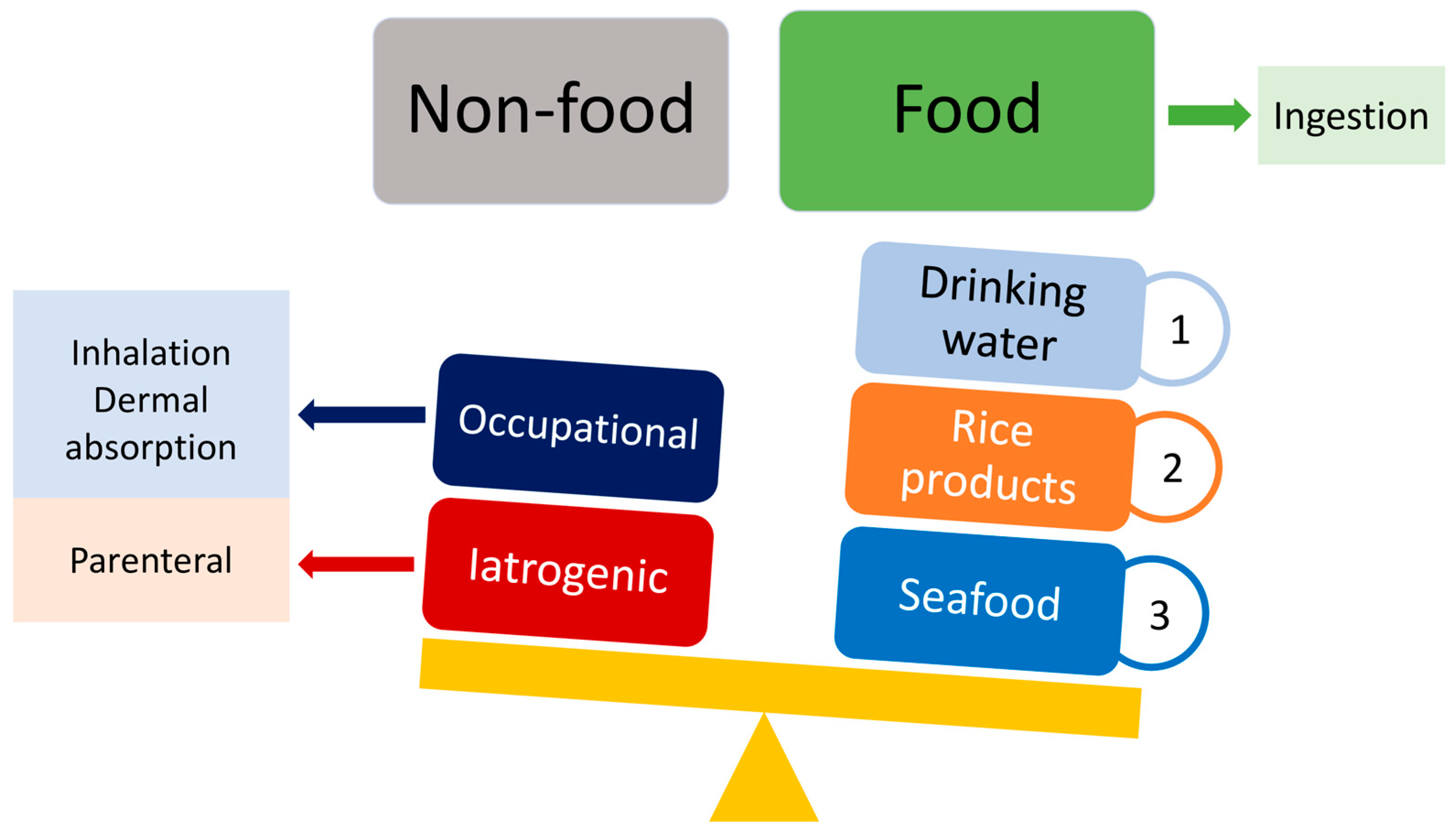
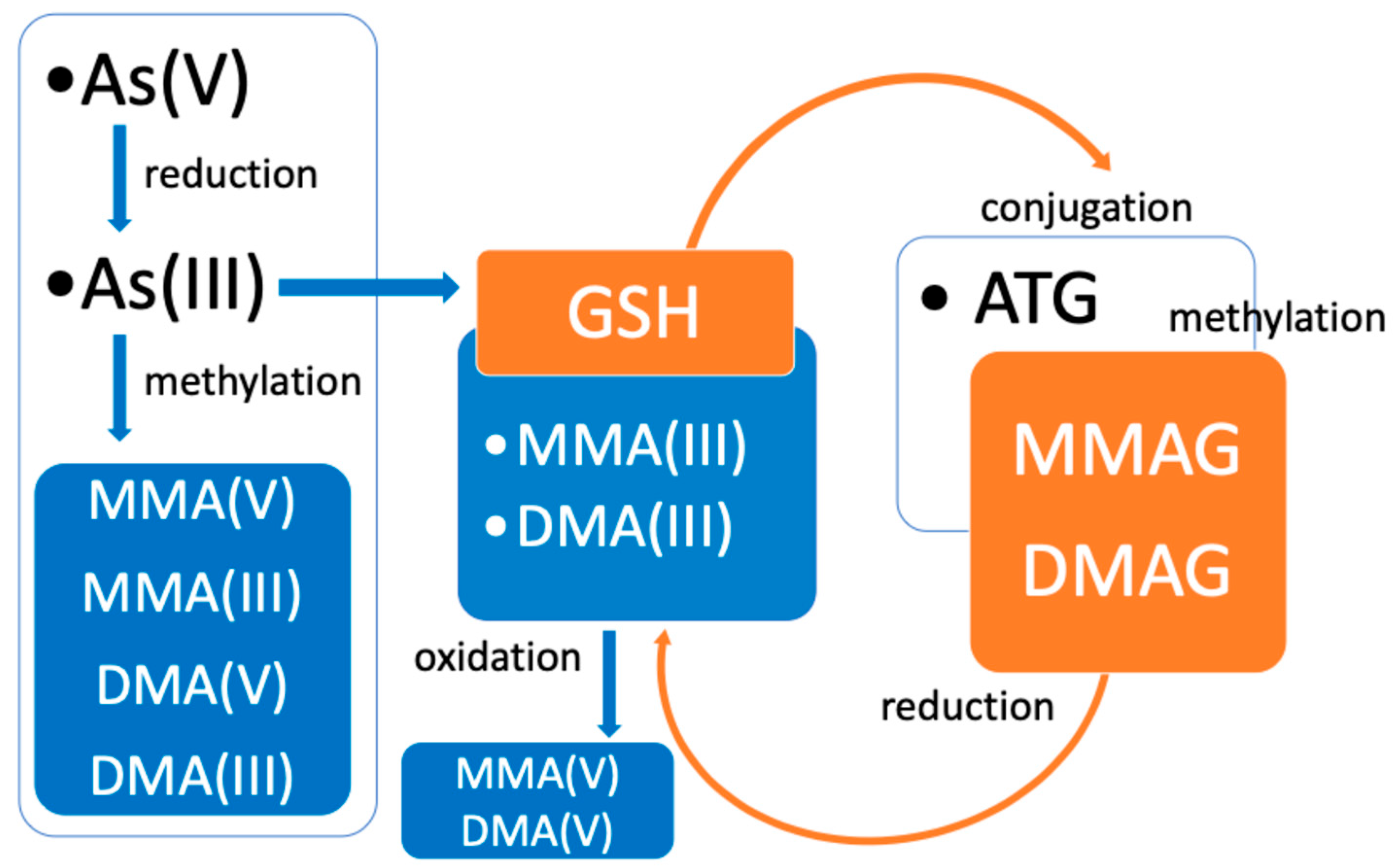
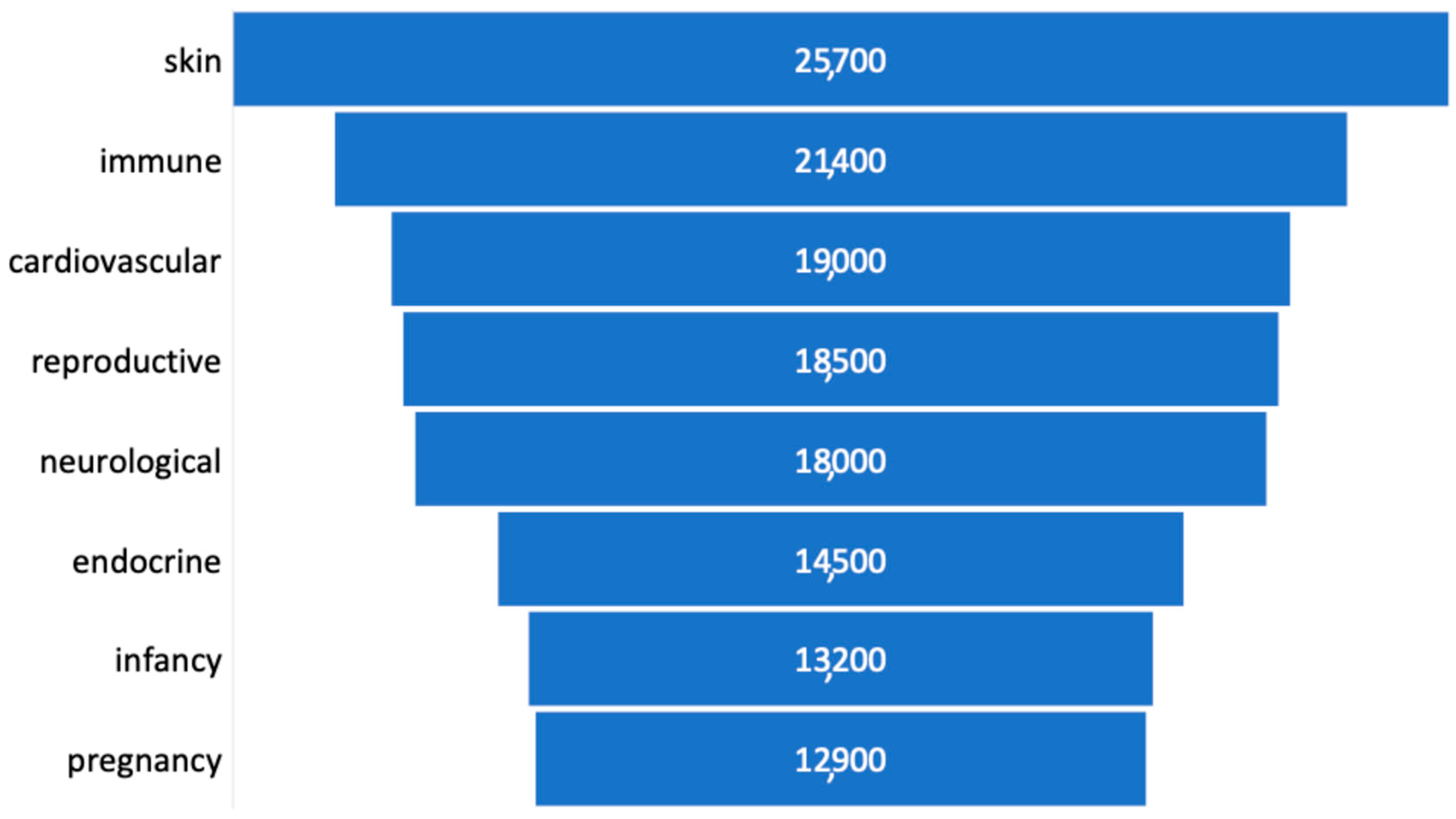
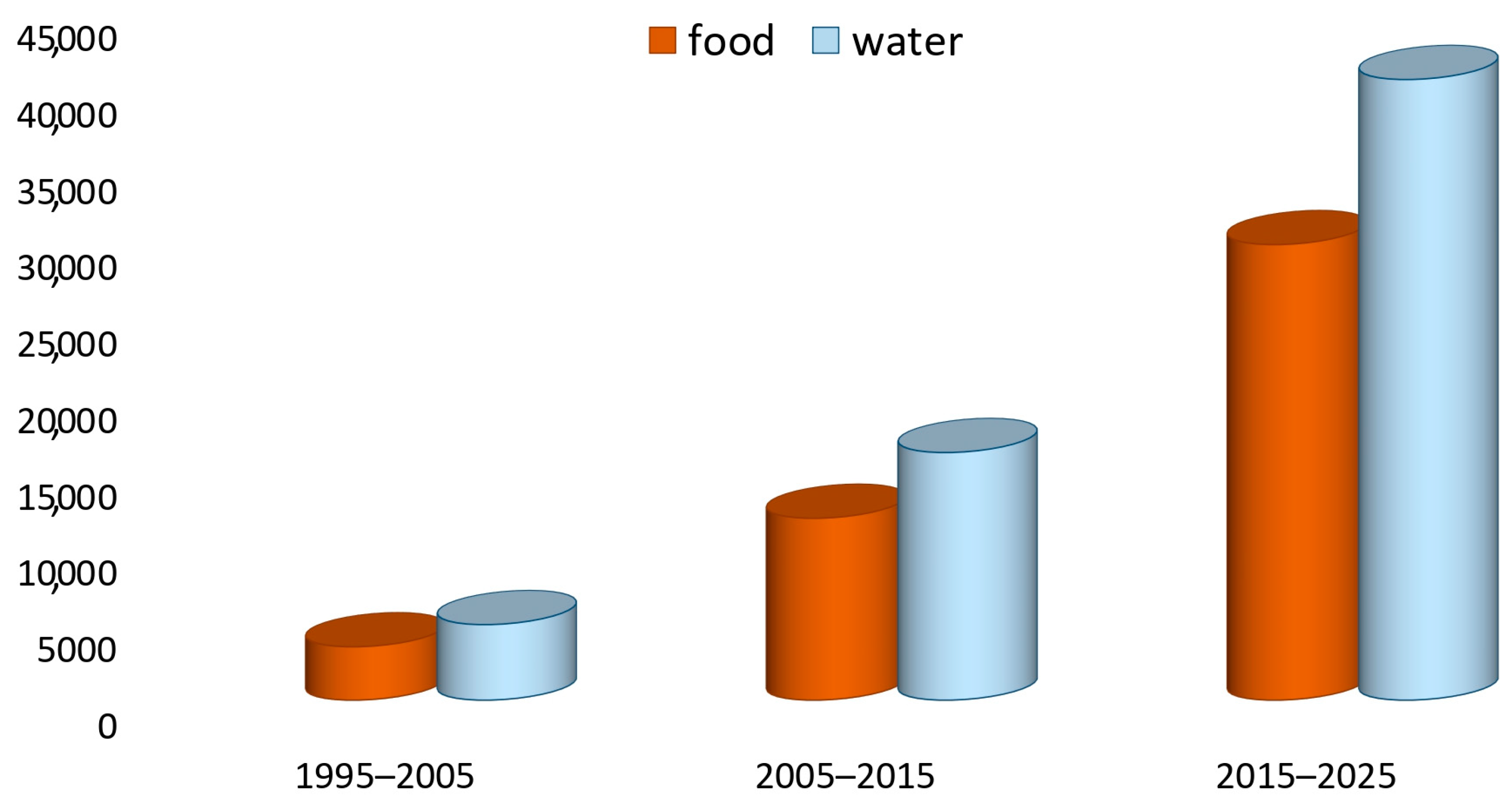

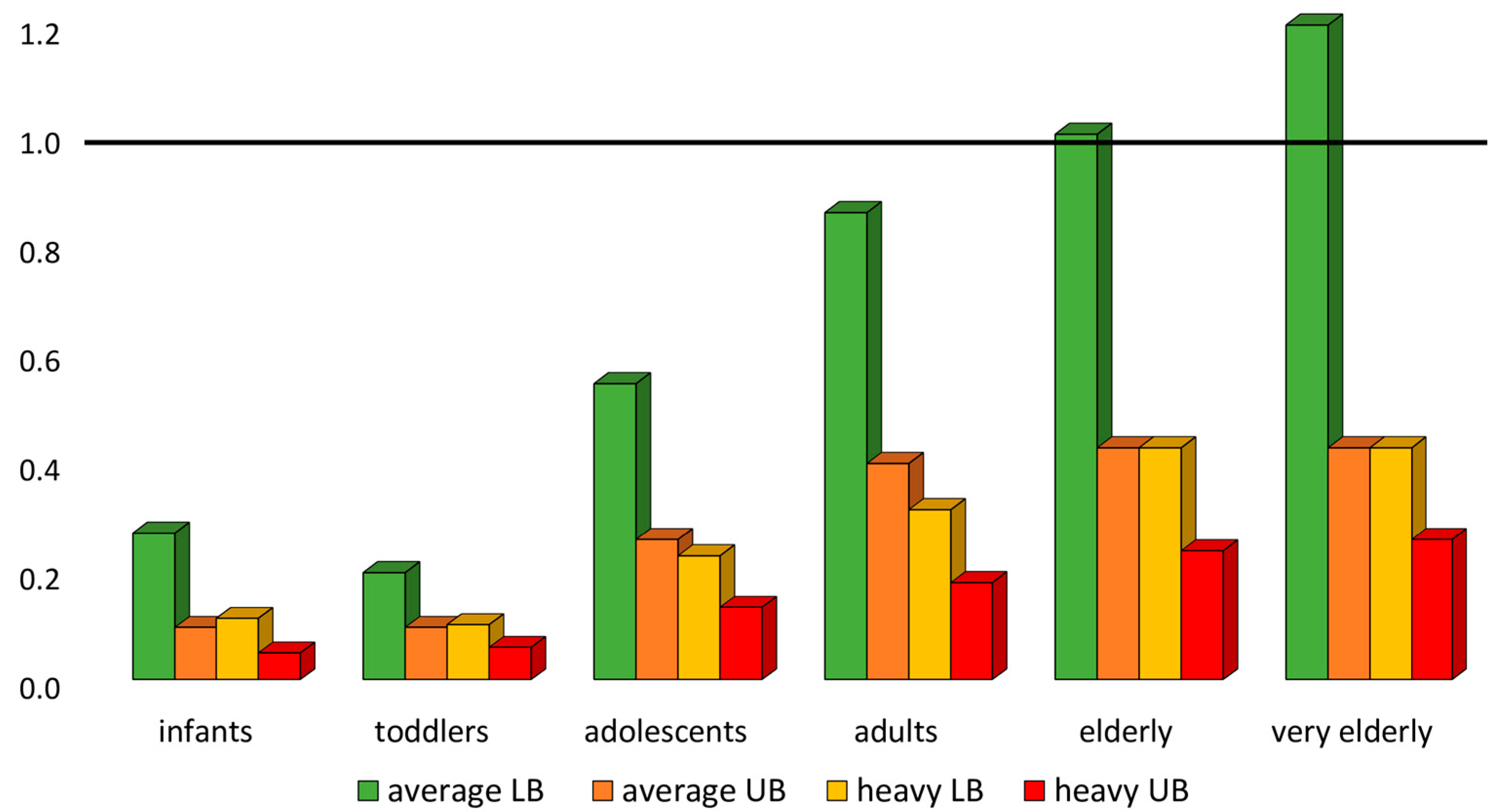
| Acronyms | Common Names |
|---|---|
| MMA(III) | monomethylarsonous acid |
| MMA(V) | monomethylarsonic acid |
| thio-MMA(V) | monomethylthioarsonic acid |
| dithio-MMA(V) | monomethyldithioarsonic acid |
| DMA(III) | dimethylarsinous acid |
| DMA(V) | dimethylarsinic acid |
| thio-DMA(V) | dimethylthioarsinic acid |
| dithio-DMA(V) | dimethyldithioarsinic acid |
| TMAO | trimethylarsine oxide |
| thio-TMA | thio-trimethylarsine |
| TETRA | Tetramethylarsonium |
| Systems/Apparatus | Adverse Effects |
|---|---|
| Respiratory | Cough, bronchitis, trouble breathing, death due to lung disease |
| Gastrointestinal | Diarrheal events in children and topical lesions on the tongue and gums |
| Cardiovascular | Arrhythmia, hypertension, atherosclerosis, death due to ischemic heart disease and stroke |
| Endocrine | Diabetes mellitus |
| Nervous | Reduced velocity of peripheral nerve conduction, peripheral neuropathy, and impaired sensory function |
| Immune | Immune activity disorders with risk of infection in neonates and delayed hypersensitivity response in adults |
| Ocular | Eye disorders such as conjunctivitis, cataracts, and pterygium |
| Development | Fetal and neonatal deaths, congenital heart defects, growth and neurological development delays, increased susceptibility to infections |
| Skin | Hyperkeratosis, hyperpigmentation, or hypopigmentation (face, neck, and back) |
| Reproductive | Endometriosis, effects on the male reproductive system and sperm quality |
| Food Categories | iAS [Sum of As(III) and As(V)] |
|---|---|
| Non-parboiled rice (polished or white) | 0.15 |
| Parboiled rice, husked rice, and rice flour | 0.25 |
| Rice products (breakfast flakes, waffles, wafers, crackers, cakes) | 0.30 |
| Rice products destined for infants and young children | 0.10 |
| Rice-based drinks | 0.030 |
| Powdered infant formulae and follow-on formulae | 0.020 |
| Liquid infant formulae and follow-on formulae | 0.010 |
| Baby food | 0.020 |
| Fruit juices and fruit nectars | 0.020 |
Disclaimer/Publisher’s Note: The statements, opinions and data contained in all publications are solely those of the individual author(s) and contributor(s) and not of MDPI and/or the editor(s). MDPI and/or the editor(s) disclaim responsibility for any injury to people or property resulting from any ideas, methods, instructions or products referred to in the content. |
© 2025 by the author. Licensee MDPI, Basel, Switzerland. This article is an open access article distributed under the terms and conditions of the Creative Commons Attribution (CC BY) license (https://creativecommons.org/licenses/by/4.0/).
Share and Cite
Visciano, P. Arsenic in Water and Food: Toxicity and Human Exposure. Foods 2025, 14, 2229. https://doi.org/10.3390/foods14132229
Visciano P. Arsenic in Water and Food: Toxicity and Human Exposure. Foods. 2025; 14(13):2229. https://doi.org/10.3390/foods14132229
Chicago/Turabian StyleVisciano, Pierina. 2025. "Arsenic in Water and Food: Toxicity and Human Exposure" Foods 14, no. 13: 2229. https://doi.org/10.3390/foods14132229
APA StyleVisciano, P. (2025). Arsenic in Water and Food: Toxicity and Human Exposure. Foods, 14(13), 2229. https://doi.org/10.3390/foods14132229






